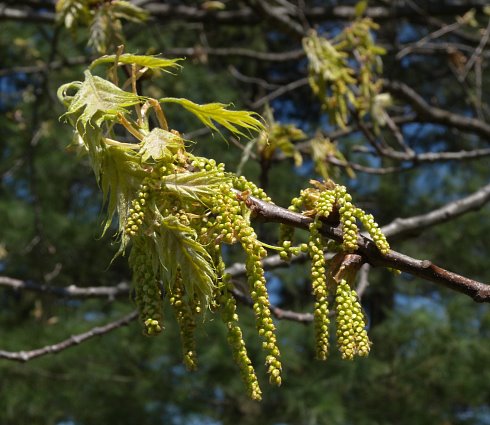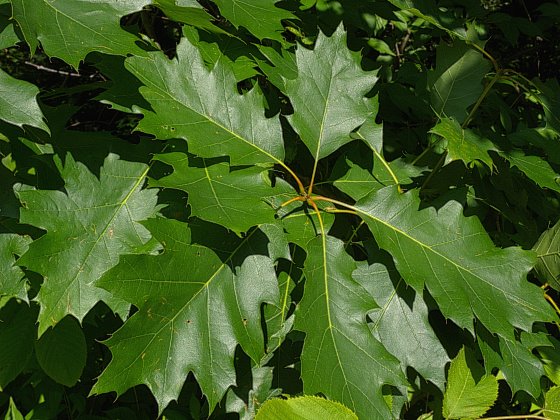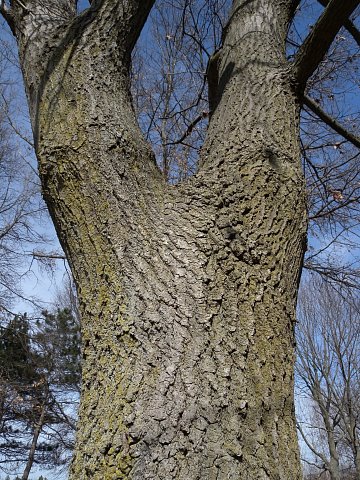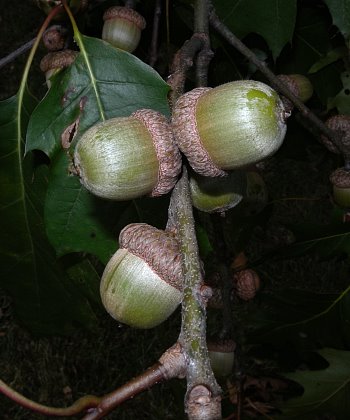
Like other oaks, Northern Red Oak is monoecious, producing male (staminate) and female (pistillate) flowers on the same tree. The male flowers are arranged in drooping yellowish green catkins about 2-4" long; these catkins often occur in groups of 3. Male catkins are produced from the axils of last year's leaves toward the tips of twigs. Individual male flowers are less than 1/8" (3 mm.) across, consisting of several stamens and a calyx that are partially hidden by hairy bractlets. Individual female flowers are produced either individually or in clusters of 2-5. Each female flower is about 1/8" (3 mm.) across, ovoid in shape, consisting of an ovary with recurved stigmas that is surrounded by a form-fitting calyx. Underneath each female flower, are several bractlets. The short blooming period occurs from mid-spring to late-spring either shortly before or during the unfolding of the vernal leaves. Afterwards, fertile female flowers are replaced by acorns that take 2 years to develop. The acorns occur individually or in groups of 2-3 on short stalks about ¼" in length or less. At maturity during the autumn, the acorns become ¾-1½" long and a little less across. The shallow cap extends about one-fourth the length of the acorn; its exterior is covered with small appressed scales that are light brown. The body of the acorn (or nut) is brown to reddish brown and smooth. The abundant meat of the nut is white and bitter. The woody root system consists of a deep taproot and spreading lateral roots. During the autumn, the deciduous leaves turn dark red or brown, sometimes persisting on the tree into winter.

Cultivation: The preference is full or partial sun, mesic to dry-mesic conditions, and soil containing deep loam or silty loam. However, Northern Red Oak also adapts to soil containing clay, sand, gravel, and rocky material. This tree develops fairly quickly for an oak and it is relatively easy to transplant. Individual trees begin to produce acorns after 25-50 years and they can live 250-500 years. Northern Red Oak is susceptible to oak wilt disease, which can be transmitted by bark beetles, grafting, contaminated pruning tools, or the roots of adjacent infected trees. This disease usually kills infected trees.
Range & Habitat: The native Northern Red Oak is a common tree that is probably found in every county of Illinois (see Distribution Map). Habitats include upland woodlands, drier areas of floodplain woodlands, north- and east-facing wooded slopes, sandy woodlands, typical savannas and sandy savannas, edges of limestone glades, wooded bluffs, and high riverbanks. Northern Red Oak is occasionally a dominant or codominant tree, but it often replaced by Sugar Maple and other trees that are more shade-tolerant. This oak is often cultivated as a landscape tree. Large trees have some resistance to wildfire, while smaller trees are usually top-killed. However, the latter sometimes resprout from their roots.

Faunal Associations: Insects that feed on the leaves, plant juices, wood, and other parts of Northern Red Oak and other oak trees (Quercus spp.) include the larvae of wood-boring beetles, leaf beetles, weevils, larvae of gall flies, plant bugs, stink bugs, aphids, leafhoppers, treehoppers, armored scales, mealybugs, larvae of gall wasps, larvae of sawflies, walkingsticks, larvae of Duskywing skippers (Erynnis spp.), larvae of Hairstreak butterflies (Satyrium spp.), and larvae of a very large number of moths. See the Beetle Table, Aphid Table, Moth Table, and Miscellaneous Insect Table for more information. These insects attract tanagers, warblers, vireos, and other insectivorous birds to oaks (Gabbe et al., 2002). The acorns of these trees are a source of food to several kinds of birds, including ducks, crows, bluejays, blackbirds, woodpeckers, upland gamebirds, and even parakeets (the introduced Monk Parakeet and extinct Carolina Parakeet); see the Bird Table for more information. Many mammals also feed on acorns; this includes the Gray Fox, White-tailed Deer, Prairie Vole, Meadow Vole, White-footed Mouse, Virginia Opossum, Raccoon, Southern Flying Squirrel, Eastern Gray Squirrel, Fox Squirrel, American Red Squirrel, Eastern Chipmunk, Muskrat (minor), and American Black Bear. The foliage and twigs of oaks are browsed by the White-tailed Deer and Elk, the bark of saplings are eaten by the Cottontail Rabbit, and the wood is eaten by the American Beaver when these trees occur near bodies of water (Martin et al., 1951/1961; Hamerstrom & Blake, 1939; Whitaker, 1966; Beeman & Pelton, 1980; Schneider et al., 2006). Northern Red Oak and other oak trees also provide protective cover for wildlife. Such birds as the Red-shouldered Hawk, Cerulean Warbler, Hooded Warbler (saplings), Eastern Wood-pewee, Yellow-throated Vireo, and Field Sparrow (saplings) select these trees as locations for their nests (Dijak et al., 1990; Newell & Rodewald, 2011; Bielefeldt & Rosenfeld, 2001; Best, 1978). Several species of bats also select these trees for daytime roost sites and locations for maternity colonies.

Photographic Location: The Arboretum of the University of Illinois in Urbana, Illinois.
Comments: This large and stately tree is justifiably popular among members of the public. It is among the largest oak trees and requires plenty of room. Among species in the Red Oak group, Northern Red Oak can be distinguished by its leaves, which are less deeply lobed than many other members of this group, and by its large acorns with shallow cups. When its leaves are exposed to the sun, its petioles are often reddish, while the petioles of other oaks are typically light green or yellowish green. Some authorities recognize a variety of Northern Red Oak, Quercus rubra borealis, that has acorns with deeper cups (extending to about one-third the length of each acorn). The wood of Northern Red Oak is hard, heavy and strong, but it is less durable in the presence of moisture than the wood of White Oak (Quercus alba). Furniture, cabinets, veneer, flooring, fence posts, caskets, and pulp for paper are made from its wood; Northern Red Oak also provides excellent fire wood.